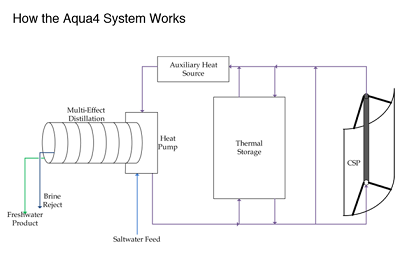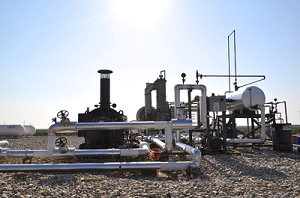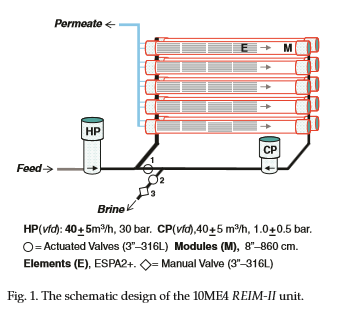Advances in Desalination Technology
More than 750 million people currently lack access to clean water worldwide.
#water-wastewater #automation
One of the technologies that has been employed for more than 60 years is desalination, but it has its own set of environmental and economic problems. The current standard technology is reverse osmosis, the process by which high-pressure pumps force water through semi-permeable membranes to exclude salt and impurities. This process uses large amounts of energy and has a large impact on the environment. These effects include damage to aquatic ecosystems, such as sucking in fish eggs with its intake water. It also uses harsh chemicals to clean membranes and it releases large volumes of highly salty liquid brine back into the water. Costs vary, but the lowest price for desalinated seawater from a reverse osmosis plant is around $750 an acre-foot (325,851 gallons).
These drawbacks have inspired several companies and research institutions to come up with technologies to improve the efficiency and safety of seawater and industrial water desalination. Here are two examples, both of which depend on valve technology to make them possible.
Closed Circuit Desalination (CCD)
This is a patented process developed by Desalitech. Rich Stover is the executive vice president of the company, and explained the technology. “One of the most common ways of desalinating is reverse osmosis, because it is the most affordable, reliable, most established, from a capital and operating cost point of view,” he said. “But RO hasn’t really changed. There have been small improvements in membrane performance, but the core process is the same as implemented in the 1970s. And it actually wastes a lot of water. One gallon of wastewater is produced for every 3 gallons of good water.”
That’s where Desalitech comes in, according to Stover. While CCD uses reverse osmosis, this new configuration can operate with 35% less energy than conventional RO systems by reducing average feed pressure requirements and eliminating or reducing brine pressure within the process prior to discharge. The company says this process is ideal for industrial water and effluent treatment, agricultural water supplies and inland brackish desalination.
There are two ways of using the CCD process: either as a stand-alone SWRO-CCD process or as a hybrid with plug-flow desalination (PFD).
“The CCD process uses a different way of feeding the membranes,” says Stover. “It’s simple but also patented, a semi-batch approach instead of a plug/flow approach. We operate RO membranes like they’re conventional filters, like a coffee filter. This is a cross-flow membrane, which means the flow goes past the membrane – instead of into the membrane. But it is done with the use of a circulation that allows operators to apply cross-flow into the membrane.” Semi-batch means the system fills up with concentrated feedwater, and then the waste is rejected into the system in a two-step process. Stover further explains: “The SWRO-CCD process uses a single-membrane pressure vessel representing multiple modules operating in parallel. A high-pressure pump (HP) feeds a closed loop comprised of a single-stage of membranes and a circulation pump (CP). Permeate is produced at a rate equal to the flow rate of the HP. Brine is recirculated in batch-like operation. When a desired recovery level is reached, brine is displaced with feed water from a hydrostatically pre-pressurized side chamber. The exchange of brine and feedwater is executed without stopping the high pressure pump, the circulation pump or the production of permeate.
The reject that comes through the valve is either discharged to the environment, if it meets the requirements, or, it is highly concentrated so it has to go to an evaporation pond, a deep well or some kind of downstream treatment.
The two-mode consecutive sequential process incorporates closed circuit and plug flow desalination (PFD). Recycled concentrate is mixed with fresh pressurized feed admitted at the inlet to the modules. When the salinity of the recycled concentrate inside the closed circuit meets the desired recovery level, the apparatus switches by operation of a valve from closed circuit to PFD until the entire brine in the closed circuit is replaced by fresh feed. Then the valve switches closed again and CCD is resumed. Most of the operation takes place in CCD mode; PFD takes place briefly, just to ensure that there is enough pressure for the brine.
Both systems result in increased water-use efficiency with less energy needed for the process. According to Stover, permeate recovery rates of over 97% can be achieved.
Concentrated Solar Still 2.0
Unlike the reverse-osmosis process that forces salt and other solids through a membrane at high pressure, Aqua4 by Water FX is at its core a concentrated solar still (CSS). While solar stills have been around for hundreds of years, this system is designed to recover water from a variety of water streams including drainage water, wastewater, produced water and seawater and turn it into pure, potable water. The company claims the system will also reclaim extracted metals and salts, removing them from the water system entirely and eliminating brine discharge.
The solar-powered heat pump acts as both a steam generator and a waste-heat recovery system. The steam generated by the heat pump drives the actual desalination of water. The desalination is performed using multiple-effect distillation (MED). MED is a method to boil saltwater to produce a high volume of freshwater and a low volume of highly concentrated brine. Because evaporation is an extremely robust treatment process that separates freshwater from almost any source, this is a reliable way to ensure that no matter what kind of water chemistry the feedstock has, the water that’s produced will be pure H2O.
Waste heat, which is produced in all distillation processes, is captured by the heat pump and recycled. Energy usage is reduced, saving costs and minimizing the footprint of the solar array.
A company spokesperson pointed out that the valving infrastructure is absolutely essential for the entire system. The company uses many kinds of conventional valve types in traditional ways— to regulate and divert streams of steam, liquid water and solar oil. Mainly on/off valves are used, from the point where the water is pumped out of the irrigation holding areas right through to when the clean water is discharged to the water district.
The company also asserts the water recovery rate is two times what it would be for older technology reverse osmosis, and achieves over 90% water recovery rate. And rather than discharging brine that must be captured and stored, the by-product here is solid. The salts and minerals in the by-product have commercial value; the salts can be used as bath salts for spas and the minerals for drywall production.
Conclusion
While the drought in California worsens and climate change threatens freshwater sources around the world, desalination may provide some relief for the millions threatened with water shortages. Whether the technological advances featured here or others being developed in research facilities elsewhere will make the process more economic and ecological is yet to be seen.
Kate Kunkel is senior editor of VALVE Magazine. Reach her at kkunkel@vma.org.
RELATED CONTENT
-
The Basics of Eccentric Plug Valves
Wastewater systems present many challenges to pumps and valves because the flow can contain grit, solids and debris, depending where in the process the equipment is located.
-
Are Bypasses Needed With Today’s Waterworks Gate Valves? New Information Says They’re Not
Gate valves are the most common valve used in the water utility industry.
-
America Moves Toward a Stronger Infrastructure
Here’s what you need to now about the multi-billion-dollar funding designated for the water and wastewater markets as part of the American Jobs Plan.













 Unloading large gate valve.jpg;maxWidth=214)